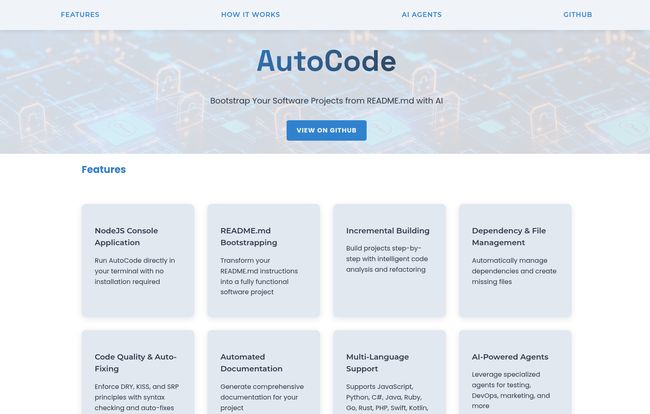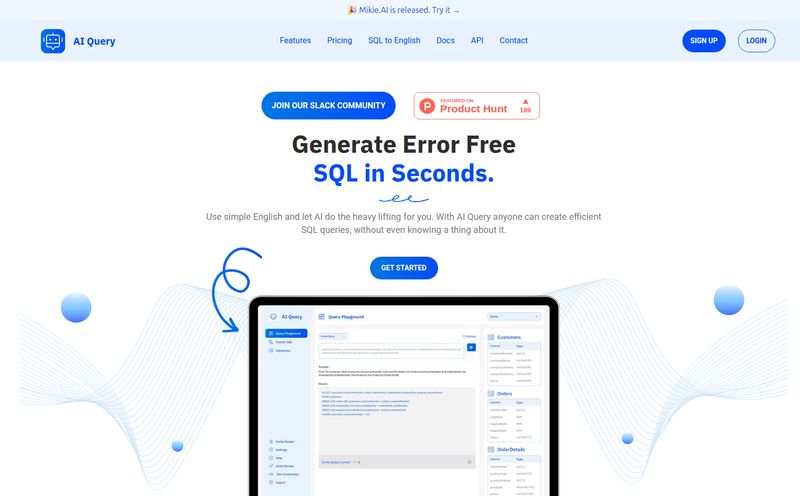As developers, we love building things. We live for that spark of a new idea, that moment when a complex problem finally clicks into place. What we don't love? The grunt work.
You know what I'm talking about. The endless setup, the boilerplate code, creating file structures, managing dependencies... It’s that initial slog that can turn a weekend project into a week-long chore. I've been in the dev and SEO world for a long time, and I've seen more brilliant ideas die on the vine from sheer setup-fatigue than I can count.
So when I stumbled upon a tool called AutoCode, my curiosity was definitely piqued. The promise? To bootstrap an entire software project just from a `README.md` file. Seriously. You write the instructions, and an AI builds the foundation. Sounds a bit like magic, right? Well, I decided to take it for a spin and see if it’s the real deal or just another drop in the AI-hype bucket.
So, What is AutoCode Anyway?
At its heart, AutoCode is an AI-powered coding assistant that lives in your terminal. But it's not like Copilot, which suggests code line-by-line. It's more of a project architect. The whole concept is beautifully simple: you create a detailed `README.md` file outlining what your project should do, its features, the tech stack, etc. Then, you point AutoCode at it.
Think of your README as the architectural blueprint and AutoCode as the AI construction crew. It reads your plans, understands the requirements using powerful language models like Anthropic's Claude 3.5 Sonnet or Google's Gemini, and then gets to work. It generates the necessary files, writes the initial code, and even handles dependencies. It's all about getting you from zero to something in record time.

Visit AutoCode
How This AI Magic Actually Works
Getting started is surprisingly straightforward, which I appreciate. No clunky desktop app to install. You just pop open your terminal, navigate to your project folder, and run a single command:
npx autocode-aiThat's pretty much it. You do need to have an API key for one of the supported AI models (like Claude or Gemini) set up as an environment variable, but that’s standard practice for anyone working with these tools. From there, AutoCode reads your README, analyzes any existing code, and starts building. It’s an iterative process, which is one of its most clever features.
The Standout Features That Caught My Eye
Okay, the core idea is cool, but what can it actually do? I dug into the features, and a few things really stood out to me.
From a Simple README to a Functional Reality
This is the main event, of course. The ability to transform plain English instructions into a working codebase is the whole selling point. It’s not just about creating empty files; it actively tries to implement the logic you describe. I found it’s best when you’re very specific in your README. The old “garbage in, garbage out” rule definitely applies here. A well-written set of instructions yields a much, much better result.
More Than Just a JavaScript Pony
I was half-expecting this to be a JavaScript-only tool, but the language support is impressively broad. It handles everything from Python, Java, and C# to Go, Rust, PHP, and Swift. This makes it incredibly versatile. Whether you're spinning up a Python backend, a React front-end, or a mobile app with Dart, AutoCode is equipped to handle the initial build. This is a huge win for polyglot developers or teams that work across different stacks.
It Builds and Thinks Incrementally
This might be its most underrated feature. AutoCode isn’t a one-and-done generator. It can work with your project as it evolves. It uses intelligent code analysis to understand your existing codebase and build upon it. This means you can run it, make some manual tweaks, update your README with new features, and run it again to have it add the new parts. It’s designed to be a partner throughout the early stages of development, not just a tool you use once.
Your On-Demand AI Dev Team
Now this is where things get really interesting. AutoCode includes a suite of specialized AI Agents. You can call on a Tester Agent to write integration tests, a DevOps Agent to configure CI/CD pipelines, or a Project Manager Agent to orchestrate the whole build process. There are even agents for Marketing and Business Analysis. It’s like having a team of junior specialists you can deploy at will. It's a bold idea, and while it's not going to replace your senior DevOps engineer, it can certainly handle the basics and save a ton of time.
The Good, The Bad, and The README
No tool is perfect, right? So let’s talk pros and cons. The biggest advantage is obviously speed. It slashes the time it takes to get a new idea off the ground. For hackathons, rapid prototyping, or just testing a new framework, it’s an absolute game-changer. The automation of documentation and code quality checks (it tries to enforce principles like DRY and KISS) are also massive pluses.
On the flip side, its effectiveness is almost entirely dependent on the quality of your README file. A vague, poorly written README will produce a messy, confused codebase. You have to be clear and explicit. And for highly complex, unconventional, or architecturally unique projects, it might struggle. You can’t just tell it to “build the next Facebook” and expect a miracle. It’s a powerful bootstrapper, not a sentient senior developer.
Let's Talk Money: AutoCode Pricing
So, what's the damage? The pricing structure is actually quite reasonable, in my opinion. They offer a few tiers that should fit most users.
| Plan | Price | Features |
|---|---|---|
| Free Tier | $0 / month | 100 requests/day, basic features, 3 devices, community support. |
| Premium | $10 / month | Unlimited requests, all features, 10 devices, priority support. |
| Enterprise | Custom | Unlimited everything, custom integrations, dedicated support, on-premise option. |
The free tier is generous enough to really kick the tires and see if it fits your workflow. For just ten bucks a month, the Premium plan's unlimited requests seem like a steal for any serious developer or freelancer.
Who Is This Tool Really For?
After playing around with it, I have a pretty clear idea of who gets the most out of AutoCode. It’s perfect for:
- Solo Developers & Freelancers: Quickly spin up new client projects or personal side hustles.
- Rapid Prototyping: Get a proof-of-concept running in hours, not days.
- Students & Learners: A fantastic way to see how a project in a new language or framework is structured.
- Small Teams: Standardize the way new microservices or projects are initiated.
If you're working on a massive, mission-critical enterprise system with a decade of legacy code, this probably isn’t the tool you'll use to build new features. But for getting new things off the ground? It's pretty darn compelling.
Final Thoughts
AutoCode is an impressive and, more importantly, a practical application of AI in the development process. It’s not trying to replace developers; it’s trying to eliminate the most tedious part of their job. It’s a force multiplier for creation.
It won't write your whole application for you, and it still requires a thoughtful human to provide a good blueprint. But by taking the drudgery out of the initial setup, it lets you focus your energy on what really matters: building cool stuff. And in my book, that’s a massive win.
Frequently Asked Questions
- What exactly is AutoCode?
- AutoCode is a command-line tool that uses AI to automatically generate a functional software project, including code and file structure, based on the instructions you provide in a README.md file.
- How does it generate the code?
- It uses large language models (LLMs) like Claude 3.5 Sonnet and Google Gemini to interpret your README, understand the project requirements, and then write the corresponding code in the language you specify.
- Is AutoCode free to use?
- Yes, there is a free tier that offers 100 requests per day, which is great for trying it out and for small projects. There are also paid plans for more heavy-duty use.
- What programming languages does it support?
- It supports a wide range of popular languages, including JavaScript, Python, C#, Java, Ruby, Go, Rust, PHP, Swift, Kotlin, and Dart.
- Are the AI model API costs included in the price?
- Yes, the requests included in the Free and Premium plans cover the cost of the underlying AI model calls. You don't need to pay separately for API usage, you just need to provide your key.
- Can I use it for commercial projects?
- Absolutely. The tool is designed to be used for both personal and commercial projects to accelerate development.



